OPINION
Architecture in the Age of the iPhone
Jason Holley, Nick Rolls and Cathrin Walczyk share their insights into the impact of technology on our spaces, and present ideas for an enhanced physical future.
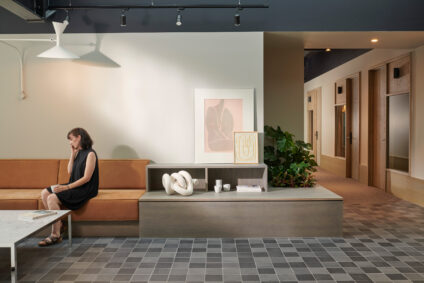
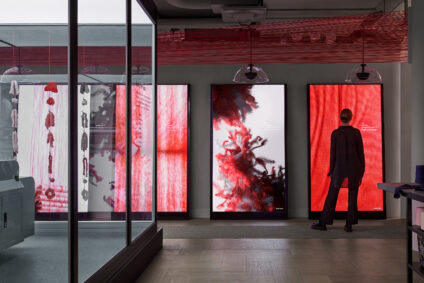
Palaeolithic Emotions and God-like Technology
In modern times nothing has evolved faster than technology and our relationship with it. Keeping up with this in the physical realm has proved difficult as we are presented with an ever-moving array of digital innovations which easily become embedded in our day-to-day lives, without consideration for how this in turn should be reasoned in physical space.
Trying to bring architecture into the age of the iPhone has had varied levels of success, with few being truly satisfactory. The revolutionary possibilities that technology offers to bring people together across geographical, economic and cultural boundaries, to broaden access to education and culture, needs to be supported by carefully designed spaces that work with it and not against it. Most importantly that work with and for the humans who use them.
For the American sociobiologist and Pulitzer Prize winning author Edward Wilson, humanity’s conundrum is this: “We have palaeolithic emotions; medieval institutions; and god-like technology.” To us, this very much sums up the challenges we are facing when designing spaces in the 21st century: The dichotomy of being biological beings, armed with a near omnipotent tool, while “stuck” in the inertia of our physical world.
While our brains are wired along patterns that made sense millions of years ago, our built environment reflects more recent (yet still not always very modern) societal structures, the technology in our hands is so powerful and fast changing that neither our brains nor our architecture are able to truly keep up.
Two Worlds Colliding
Our digital and physical worlds have been colliding in a less-than harmonious way with clumsy integration, gimmicky solutions and a true dissonance between technology and the spaces it got dropped into. This has been perpetuated further as technology has galloped ahead, with attempts to integrate it into physical space quickly becoming obsolete.
In the wake of this we see a new relationship emerging: one in which we no longer try to ‘technify’ our architecture but instead see technology as a standalone layer within it. We can now turn any material into an interactive surface with projection mapping, and we all carry powerful computers in our pockets, ready to switch the digital world on and off.
In this new approach, spaces have become liberated: to be more physical, to be more intense and characterful, to provide stronger in-the-real world experiences that - as yet, and probably for a long time - cannot be experienced virtually. We believe that herein lies the key potential of this new approach: in making spaces more physical - making use of all the tools we have for experiencing space: touch, smell, sound, fostering human interaction and collectivity, and helping us reconnect with our surroundings.
As a counterpoint to the ever-present draw of the digital, we need to enhance and amplify simple and serendipitous physical pleasures like watching dappled light play through a moving curtain, holding on to a well-shaped handrail, the serenity of walking through a grand and tall-ceilinged lobby, or the multi-layered and rich energy that comes from a bustling restaurant. Effectively, we need to dial up the things that make living in the real world worthwhile. Smaller design details that consider how tech makes us want to use space can also help to bridge the gap.
We’re constantly consuming content on our phones, from a busy tube carriage filled with heads down or once livelier café and social spaces. If we had environments that offered some degree of indeterminacy or openness it would allow us to find spaces appropriate to our needs that supported different modes of our day. We would be able to read the spaces ourselves and understand what suits us best. This could be as simple as a discreet ledge where people can perch to take an important call, send an email or to look something up online whilst also being able to enjoy the space they are in. We should be creating spaces that are generous and are genuinely human focussed.
This type of non-overt tech integration can be hugely successful. At Ace Hotel London we included a large communal table in the design of the lobby, envisaging this space as an environment for the local community as much as travellers.
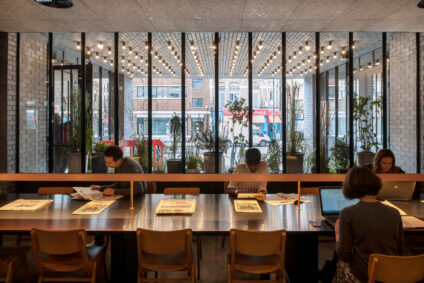
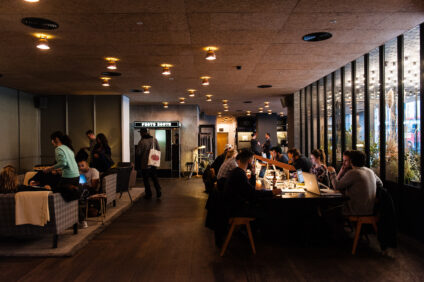
This central table acted as a hub for coworking, a relatively recent digital habit at the time, and transitioned into a social space for drinks in the evening. To achieve this we used subtle clues such as changes in lighting and acoustics to redefine the space over the course of the day, out of a space for working and into a space focused on human interaction.
We Shape Our Tools, and Our Tools Shape Us
The original vocabulary of the tech world used concepts borrowed from the real world - the ‘home page’ and ‘windows’, while new ways of doing things online have in turn created new real world archetypes - digital is reflecting back into the physical. The tech enabled sharing economy has given birth to new typologies of shared spaces like coworking or being able to rent out your own home on Airbnb. On the other side we have the digital world trying to replicate rituals and interactions that are an integral part of our societies.
The serendipitous chats you would have around the office coffee machine or before a meeting starts have been cut out in the digital versions of working and meeting. New formats in the digital sphere are being hastily crafted to rectify this, unsurprisingly once again using real world typologies: “Break-out rooms”, or the “Together” mode on Zoom, imitating all participants sitting in an auditorium-type seating arrangement to reproduce some relationality.
It feels like a constant bout is between the two worlds, the digital one endlessly expanding its reach and possibilities, while the physical world sluggishly but sometimes also dramatically changing shape in response. Paradoxically, the current crisis has as much entrenched our reliance on technology as it has reminded us of the pleasures to be found in the non-virtual world.
Tech Loves Design, Design Loves Tech
There has always been a strong “love affair” between tech and design. Apple for example, has always heavily relied on design to tell stories and communicate the allure of its products, while the design world has forever been transfixed by technology’s seemingly endless possibilities to expand our capabilities. Entire design careers have been defined by commissions from the tech sector - if you think about the Eames partnership with IBM or Dieter Rams’ iconic creations for Braun.
Our studio worked with IBM on their flagship demo space in Munich, creating a space which broke down Internet of Things technology: an incredible range of sensors and data capturing devices that can be implanted into virtually any product, from Formula 1 racing cars to washing machines.
Through workshops we established aesthetic and experiential expressions of not only this emerging technology but also of who they are as an organisation.
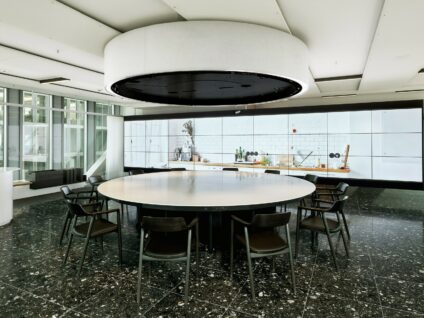
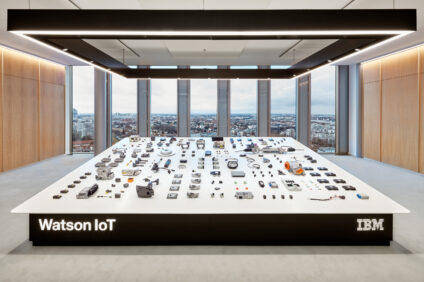
We used our storytelling skills to help IBM communicate the possibilities of the technology and bring to life its magic in an experiential way - ultimately, to make the intangible tangible.
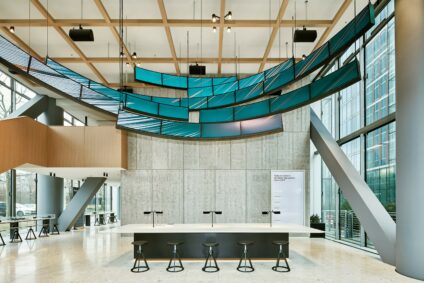
Invisible Tech
At its best, technology in spaces is not an after-thought or add-on but is truly integrated and intuitive. A seamless layer that supports the smooth functioning of spaces and the thriving of human life, not obtrusive or attention-grabbing. Using technology in the background has already been helpful in commercial environments. In the co-working world, large providers take on leases and then sublet shorter, more flexible leases to multiple smaller tenants, with the administrative complexity of the multi-tenant model managed through digital apps. We believe that something similar will soon be happening in the retail sector, enabling a move away from the single brand anchor tenant model and instead enabling a more dynamic and adaptable model of multiple smaller tenants.
This could mean that they might share resources and services like logistics, administration, staffing etc. For the spaces they inhabit it will mean a rethink of how this new flexibility is expressed, how furniture and fixtures and the spaces themselves become adaptable and shareable, and how the design of the spaces incorporates a more collective expression of identity. The agility of this new model also lends itself to strengthening brick and mortar retail and helping to reinvent the waning high street.
We are also interested in the moments when tech liberates spaces from their functionality, and in doing so also liberates our behaviour. The weekly grocery shop, previously a cornerstone of our societies featuring bartering, chatting and joking has since been reduced to a line of self-checkouts and a built expression of the now very lonely act of trading goods. Perhaps new generations of technology like Amazon Go, where you omit the act of checking out and simply leave the store while the correct amount of money is being deducted from your wallet, will re-enable the collective human experience that going to the market once was. Freed of the inconvenience of the act of payment, stores might reinvest in human staff and real-world experience to counteract the ever growing world of online shopping. One could argue that the same has happened to our workspaces, where wifi and laptops have freed up the office environments from their functional burdens to become more characterful, more comfortable and ultimately more human.
Using coworking spaces as an example once again highlights how the tech-enabled communities are brought together by the spaces they inhabit - in which they exchange and meet, in which they identify with a built expression of their values through objects/design/ furniture, and in which they form real life connections. At BT’s new London headquarters, one of our current projects, we are designing rooms for staff and visitors meeting physically and virtually. For those accessing the space for face-to-face meetings, we were briefed to create an unmatched experience, to ensure that time spent here is fruitful and unparalleled in terms of whether it could be replicated elsewhere.
Guests to the Customer Experience Centre are taken on a physical journey through a series of concentric spaces, part of which is designed to be entirely non-digital, including a ‘pre-flight’ space, allowing for people to be able to gather and talk with colleagues before walking through the ‘portal’ and journeying into the experiences beyond. The central ‘Futurezone’ is a showcase space for complex tech-based demos with customizable content shown through AV as architecture (large scale screens). The combination of spatial, sensory and physical is designed to evoke drama and awe, and a way to make the intangible tangible. It can be equated to a band spending time in a recording studio – the right environment to encourage the best outcomes.
“Always design a thing by considering it in its next larger context— a chair in a room, a room in a house, a house in an environment, an environment in a city plan.” —Eliel Saarinen
Being Human in the Digital Age
The multiple interfaces with which we interact on a daily basis are an invasion of our bodies and our world. This invasion can offer the most transportive and also the most disruptive experiences. At its most extreme, tech takes you away from where you are. That creates a new problem for physical space - how should it manifest itself to deal with this ‘out of body’ alternative experience?
Seen from this perspective, Eliel Saarinen’s quote “Always design a thing by considering it in its next larger context—a chair in a room, a room in a house, a house in an environment, an environment in a city plan” suddenly gains a new dimension: What if the next space outside the chair is actually the whole virtual world? How do we design a space that is simultaneously nested within its real world local context as well as the endless digital universe? Can we design transitional spaces that make the move in and out of the digital world more seamless and less abrupt? Can we create better interfaces that remove the device between us and the virtual world? What does privacy mean if the whole world can look back at us through our phones? And if we are connected with virtually every other point on the globe, where do we find our authenticity and grounding, what do we draw on for our cultural identity?
All of these are important questions to ask when designing physical environments today. We need to design with people’s constant ‘on-ness’ in mind, with the virtual world being omnipresent, even if we can’t see or touch it at all times. The relatively new science of neuroaesthetics has revealed that we experience architecture and spaces with the same reward systems in our brain associated with satisfying primary pleasures like food and sex, and that specialised cells are attuned to the geometry and arrangement of the environments we inhabit. Buildings and cities can affect our mood and wellbeing; it is imperative that we design them as counterpoints to social fragmentation, isolation and algorithmic prediction, providing sensory and collective experiences, as well as safety and relatability. To some degree, the mere existence of the digital world has put a new responsibility and pressure onto the physical world - to help us stay human.
This comes back to our palaeolithic impulses and the seductiveness of technology - we need to also focus our attention on the here and now if we don’t want to lose our physical connectedness to the world or each other. As the creators of the spaces that we spend most of our time in every day, architects and designers need to work harder to enable togetherness and a sense of being in the world.
Humanness in Digital Interactions
Tech, too, needs to evolve. The crudeness of our devices as they currently work makes them the rudest person in the room - their capacity for subtlety falters in comparison to the context of the rich palette of human expressions. In a year when the majority of our work activity has happened online, we are still far from having learnt how to actually interact with each other in humane, polite and engaging ways in the digital realm. The lackluster quality of our interactions coupled with the crudeness of our digital communication is a bad replacement for real-life exchanges. Social rituals and familiar behaviours, however small, create organic and meaningful connections. From walking together to entering a space or the small talk before a meeting, the fragments of interactions we are used to do not yet have satisfying digital counterparts. We need to look at how we can design tech to allow us to behave in a natural way and not feel stilted under the spotlight.
Virtual Expansion
At the other end of the spectrum, we are seeing an expansion into the virtual universe - from crypto art to virtual DJ sets and online runway shows, the spaces created in the virtual world are gaining more cultural and commercial traction and are becoming more sophisticated, more intense, more fanciful. We are discovering the seemingly endless possibilities of storytelling in a world in which no physical laws apply - from shape-shifting to scale-shifting to disappearing and reappearing, the new realms of the virtual provide a playground for designers to create fantastical worlds with no boundaries. We have recently started developing these worlds for our commercial clients, trying to transport their ethos and aesthetic codes into the digital world, amplifying and dialling it up in the process.
The emerging joined-up universe straddles all communication channels and fuses to a holistic narrative in the collective minds of their followers. We are currently developing a laboratory space in Monaco for French skincare company Biotherm with this in mind, exploring how what we can do virtually can support, enhance and expand the brand’s ocean protecting ethos and take their customers on a transformative journey.
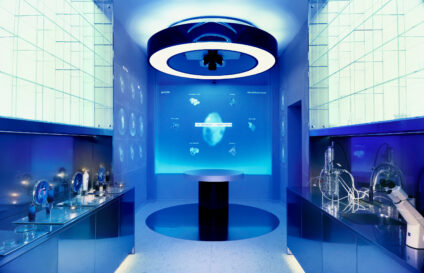
Conclusion
We need to achieve a better balance between the digital and the physical and make technology in spaces work better for us and our humanness. We should be using tech to enhance and/or simplify our interactions. Our non-digital world should be celebrated for its potential to nurture us, be connected to others, to make us feel safe, comfortable, in awe, or simply human. To better serve our humanity with tech-enabled spaces, we need to foster a deep understanding of the relationship between our human nature, our spaces, and technology. This means to understand our strengths and weaknesses as a species and to offset in the real world the threat of alienation and estrangement that the virtual realm poses. Only then will we regain control over those god-like powers and use them to empower our lives offscreen.